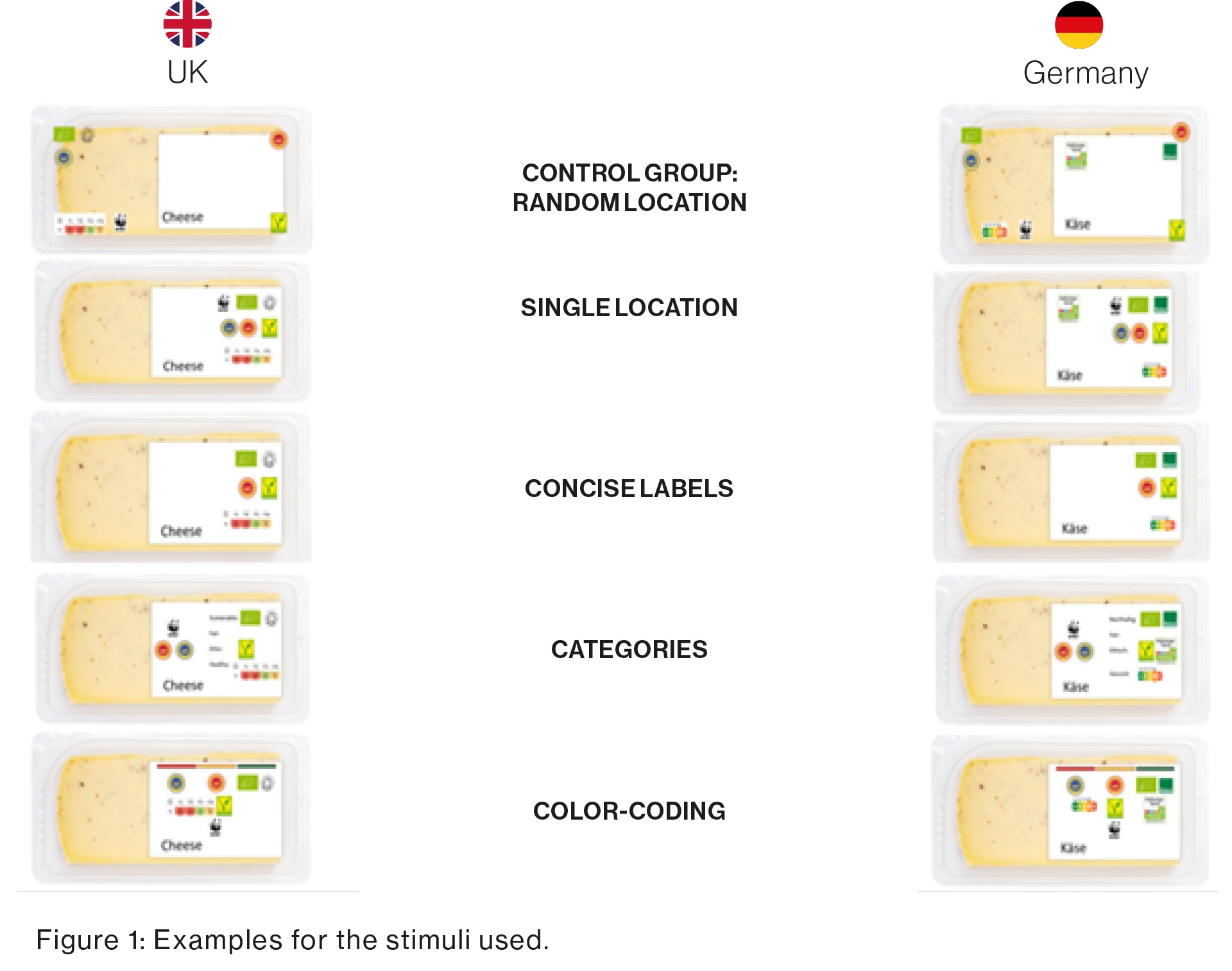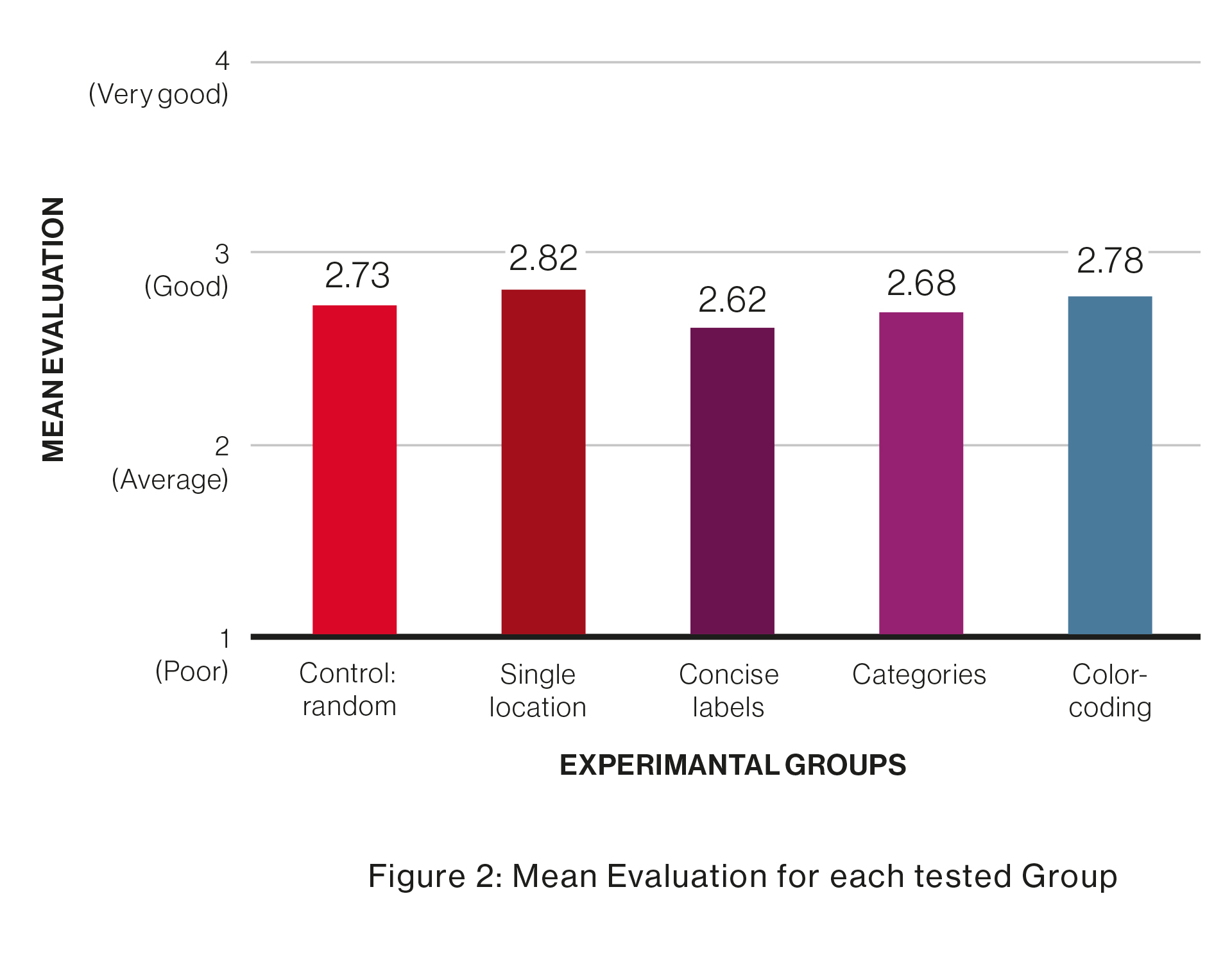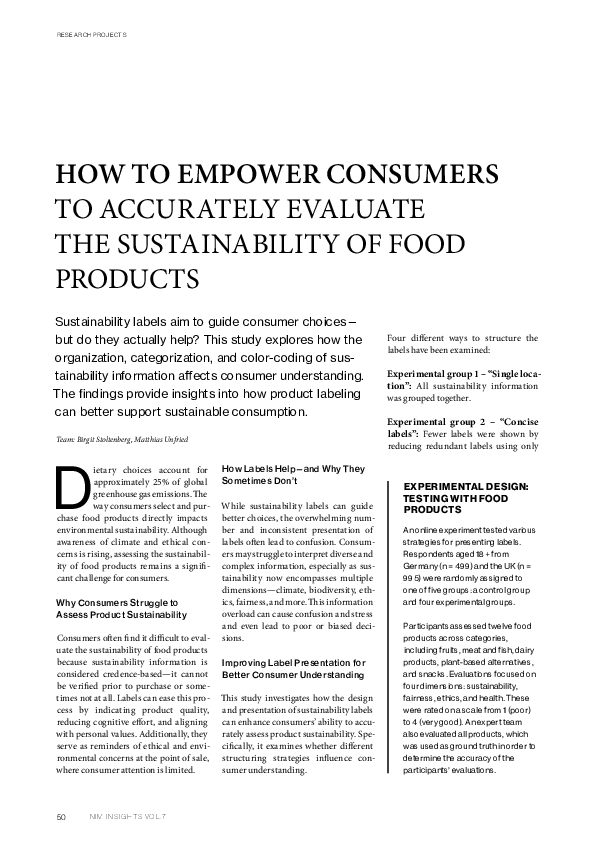Forschung
Stoltenberg, B., & Unfried, M. (2025). How to Empower Consumers to Accurately Evaluate the Sustainability of Food Products. NIM INSIGHTS Research Magazin VOL. 7
How to Empower Consumers to Accurately Evaluate the Sustainability of Food Products
Sustainability labels aim to guide consumer choices—but do they actually help? This study explores how the organization, categorization, and color-coding of sustainability information affects consumer understanding. The findings provide insights into how product labeling can better support sustainable consumption.
Dietary choices account for approximately 25% of global greenhouse gas emissions. The way consumers select and purchase food products directly impacts environmental sustainability. Although awareness of climate and ethical concerns is rising, assessing the sustainability of food products remains a significant challenge for consumers.
Why Consumers Struggle to Assess Product Sustainability
Consumers often find it difficult to evaluate the sustainability of food products because sustainability information is considered credence-based—it cannot be verified prior to purchase or sometimes not at all. Labels can ease this process by indicating product quality, reducing cognitive effort, and aligning with personal values. Additionally, they serve as reminders of ethical and environmental concerns at the point of sale, where consumer attention is limited.
EXPERIMENTAL DESIGN: TESTING WITH FOOD PRODUCTS
An online experiment tested various strategies for presenting labels. Respondents aged 18+ from Germany (n = 499) and the UK (n = 995) were randomly assigned to one of five groups: a control group and four experimental groups. Participants assessed twelve food products across categories, including fruits, meat and fish, dairy products, plant-based alternatives, and snacks. Evaluations focused on four dimensions: sustainability, fairness, ethics, and health. These were rated on a scale from 1 (poor) to 4 (very good). An expert team also evaluated all products, which was used as ground truth in order to determine the accuracy of the participants’ evaluations.
How Labels Help—and Why They Sometimes Don’t
While sustainability labels can guide better choices, the overwhelming number and inconsistent presentation of labels often lead to confusion. Consumers may struggle to interpret diverse and complex information, especially as sustainability now encompasses multiple dimensions—climate, biodiversity, ethics, fairness, and more. This information overload can cause confusion and stress and even lead to poor or biased decisions.
Improving Label Presentation for Better Consumer Understanding
This study investigates how the design and presentation of sustainability labels can enhance consumers’ ability to accurately assess product sustainability. Specifically, it examines whether different structuring strategies influence consumer understanding.
Four different ways to structure the labels have been examined:
Experimental group 1 – “Single location”: All sustainability information was grouped together.
Experimental group 2 – “Concise labels”: Fewer labels were shown by reducing redundant labels using only the label per category with the highest standards.
Experimental group 3 – “Categories”: Information was organized by category (e.g., environmental, ethical).
Experimental group 4 – “Color-coding”: A graded color scheme was applied.
In each group, participants were asked to evaluate the products with respect to sustainability, fairness, ethics, and health aspects, which was used to analyze the influence of information presentation on consumers’ perception. Additionally, we compared whether the accuracy of these evaluations differed between the groups.

How Different Labeling Strategies Affect Consumer Evaluations and Accuracy
Consumer evaluations were influenced by the way sustainability labels were presented. In particular, reducing the number of labels—as in the “Concise labels” group—had a significant negative effect on product evaluation; see Figure 2. However, accuracy remained unaffected. This suggests that removing redundant information can impair perceived product value without improving evaluation precision.
Across all experimental groups and countries, systematic biases in product evaluations emerged. Meat, milk, and chocolate were consistently overestimated across all label dimensions, while plant-based alternatives—especially oat drinks—were systematically underestimated. Ethical ratings for vegan products (e.g., oat drinks, apples, tomatoes) were particularly low, and fairness was generally overestimated across groups. These biases appeared independent of labeling strategy. Only one labeling strategy, the “Categories” group, significantly improved both evaluation accuracy and rating distinctiveness. This group evaluated the products as more differentiated and showed the highest overall accuracy.

Implications
Academia: Further research is needed to understand how consumers process sustainability information and which framing strategies enhance product assessment and decision-making.
Businesses: Clear, structured, and standardized labeling can improve trust and comprehension. However, excessive simplification may backfire. Categorization emerged as the most effective strategy.
Consumers: Common misconceptions persist—animal-based products are often assessed too positively and plantbased alternatives too negatively in terms of sustainability.
Public Policy: Standardized and clearly categorized sustainability labeling could help reduce consumer confusion.
KEY INSIGHT
- This study highlights both the potential and limitations of sustainability labels in promoting informed consumer decisions. While categorizing sustainability information can improve evaluation accuracy, other strategies—such as color-coding or simplifying (“Concise labels”)—showed minimal or even negative effects.
Projektteam
- Birgit Stoltenberg, Senior Researcher, NIM, birgit.stoltenberg@nim.org
- Dr. Matthias Unfried, Head of Behavioral Science, NIM, matthias.unfried@nim.org
Kontakt
Stoltenberg, B., & Unfried, M. (2025). How to Empower Consumers to Accurately Evaluate the Sustainability of Food Products. NIM INSIGHTS Research Magazin VOL. 7

